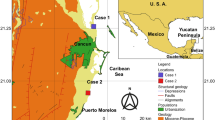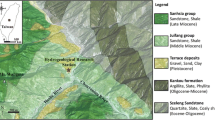Abstract
This study used optical brighteners (OB) released from septic systems to show that groundwater flow direction is largely controlled by the structural framework in a faulted karst groundwater system. Effective protection of groundwater resources requires that groundwater systems are adequately characterized and source water protection areas (SWPA) are developed for drinking water wells. Karst aquifers are among the most sensitive to contamination due to high recharge rates, and among the most difficult aquifers to characterize due to heterogeneity, and anisotropy. Because septic systems may be used to treat wastewater within SWPAs for karst aquifers there is a need to characterize these groundwater systems using tracers. The objective of this study was to characterize groundwater flow in a faulted portion of the Edwards aquifer in Bexar County, Texas using OB that are released as incidental tracers from septic systems. This study included measurement of water levels, sampling of groundwater and surface water, analysis for OB, and spatial analysis in a GIS. Results show that OB intensities were highest to the southwest of the septic area, a direction that is sub-parallel to the fault and fracture orientation and nearly perpendicular to the hydraulic gradient. This indicates that movement of OB, solutes, or non-aqueous liquids/solids in a faulted karst system can be largely controlled by fault/fracture orientation and structural relay ramps.






Similar content being viewed by others
References
Alhajjar BJ, Chesters G, Harkin JM (1990) Indicators of chemical pollution from septic systems. Ground Water 28(4):559–568
Arnow T (1963) Groundwater geology of Bexar County, Texas. US Geological Survey Water-Supply Paper 1588: pp 36
Davis SN, Thompson GM, Bentley HW, Stiles G (1980) Ground-water tracers—a short review. Ground Water 18(1):14–23
DWAFWRC Department of Water Affairs and Forestry and Water Resources Commission (1996) The philosophy and practice of integrated catchment management: implications for water resource management in South Africa. WRC Report No TT 81/96, Pretoria: pp 139
Fay SR, Spong RC, Alexander SC, Alexander ECJ (1995) Optical brighteners: sorption behavior, detection, septic system tracer applications. Paper presented at the International association of hydrogeologists XXVI international congress, Edmonton, Alberta
Ferrill DA, Sims DW, Waiting DJ, Morris AP, Franklin NM, Schultz AL (2004) Structural framework of the Edwards Aquifer recharge zone in south-central Texas. GSA Bull 16(3/4):407–418
Frost FJ, Kunde TR, Craun GF (2002) Is contaminated groundwater an important cause of viral gastroenteritis in the United States? J Environ Health 65(3):9–14
Harris PJ (1995) Water quality impacts from on-site waste disposal systems to coastal areas through groundwater discharge. Environ Geol 26:262–268
Holmbeck-Pelham SA, Rasmussen TC, Fowler LA (2000) Regulation of injected ground water tracers. Ground Water 38(4):541–549
Hutson SS, Barber NL, Kenny JF, Linsey KS, Lumia DS, Maupin MA (2004) Estimated use of water in the United States in 2000. US Geological Survey Circular 1268. Denver, CO, pp 46
Maclay RW (1995) Geology and hydrology of the Edwards aquifer in the San Antonio area, Texas. US Geological Survey Water-Resources Investigations Report 95–4186, pp 64
Mull DS, Liebermann TD, Smoot JL, Woosley LH (1988). Application of dye-tracing techniques for determining solute-transport characteristics of ground water in karst terrains. EPA 904/6–88-001. US Environmental Protection Agency Region 4, Atlanta, Georgia
Pantea MP, Cole JC (2004) Three-dimensional geologic framework modeling of faulted hydrostratigraphic units within the Edwards aquifer, northern Bexar County, Texas. US Geological Survey Scientific Investigations Report 2004–5226, Denver, Colorado pp 10
Rose PR (1972) Edwards Group, surface and subsurface, Central Texas, University of Texas. Bureau of Economic Geology Report of Investigations No. 74, Austin, Texas pp 198
Sankaran S, Rangarajan R, Dhar RL (2005) Delineation of hydraulic connectivity across a dolerite dyke through hydrogeological, geophysical and tracer studies-a case study. Environ Geol 48:411–419
Schindel GM, Quinlan JF, Davies G, Ray JA (1997) Guidelines for wellhead and springhead protection area delineation in carbonate rocks. EPA/904/B-97/003, United States Environmental Protection Agency
Sharp JM, Banner JL (1997) The Edwards aquifer: a resource in conflict. GSA Today 7(8):1–9
Smart CC, Karunaratne KC (2002) Characterisation of fluorescence background in dye tracing. Environ Geol 42:492–498
Stein WG, Ozuna GB (1996) Geologic framework and hydrogeologic characteristics of the Edwards aquifer recharge zone, Bexar County, Texas. Austin, TX. US Geological Survey Water-Resources Investigations Report 95–4030, pp 8
Stumm W (1985) Clean shirts and clean water. Environ Sci Technol 19(11):1013
USBR United States Bureau of Reclamation (2003) Water 2025: preventing crises and conflict in the West, USBR Fact Sheet, pp 27
USEPA United States Environmental Protection Agency (2003) Voluntary national guidelines for management of onsite and clustered (decentralized) wastewater treatment systems. EPA 832-B-03–001
Veni G (1999) A geomorphological strategy for conducting environmental impact assessments in karst areas. Geomorphology 31:151–180
Veni G (2002) Revising the karst map of the United States. J Cave Karst Stud 64(1):45–50
Yates MV (1985) Septic tank density and ground water contamination. Ground Water 23(5):586–591
Acknowledgments
Funding for this research was provided by the Center for Water Research at the University of Texas at San Antonio. We thank the City of Shavano Park, San Antonio Water System, and the Edwards Aquifer Authority for assistance with field sampling, laboratory equipment use, and permission to access wells. Thank you also to Dianne Hart with the City of San Antonio for assistance with GIS. Anonymous reviewers are also acknowledged for providing input to improve this paper.
Author information
Authors and Affiliations
Corresponding author
Rights and permissions
About this article
Cite this article
Murray, K.E., Straud, D.R. & Hammond, W.W. Characterizing groundwater flow in a faulted karst system using optical brighteners from septic systems as tracers. Environ Geol 53, 769–776 (2007). https://doi.org/10.1007/s00254-007-0689-7
Received:
Accepted:
Published:
Issue Date:
DOI: https://doi.org/10.1007/s00254-007-0689-7




